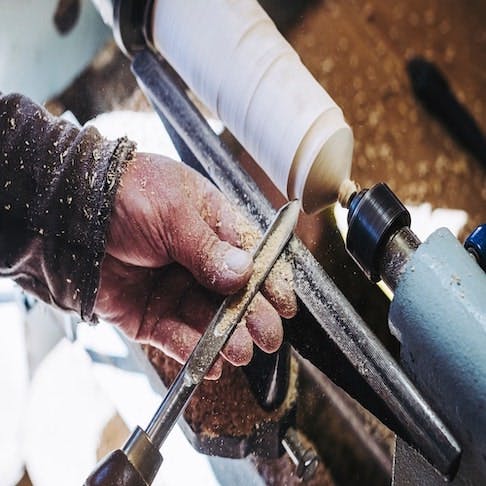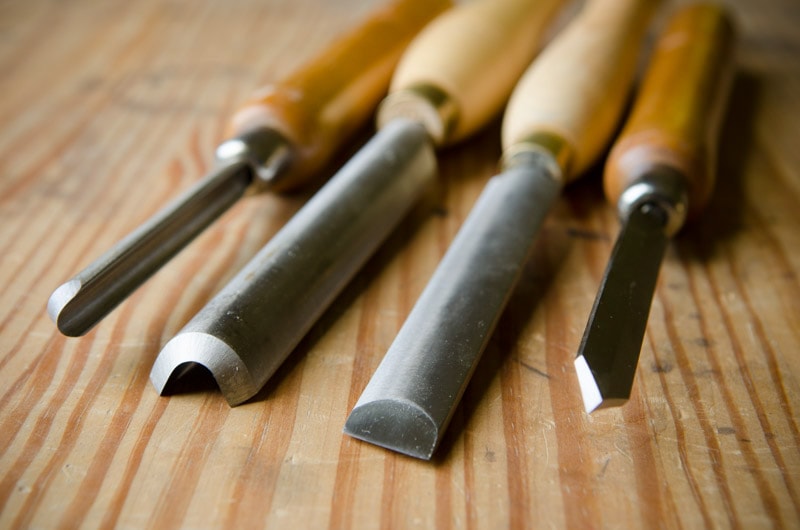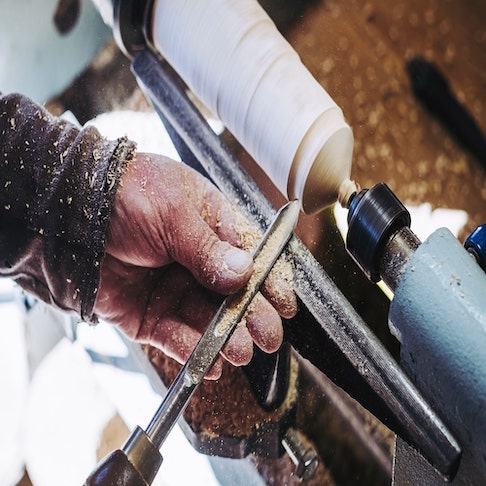Can I use wood chisels on a lathe? If you’re a woodworking enthusiast or just curious about lathes, this question may have crossed your mind. Well, you’ve come to the right place! In this article, we’ll delve into the world of wood chisels and lathes to give you a clear answer. So, let’s get started and explore the fascinating intersection of these two handy tools!
When it comes to woodworking tools, versatility is a coveted trait. You want tools that can handle different tasks, maximizing their usefulness. And that’s where the question of using wood chisels on a lathe arises. Can these chisels, primarily designed for hand carving, be used on a lathe to shape and sculpt wood? Well, my curious reader, buckle up as we embark on a journey to find out!
Woodworking is an art, blending creativity and craftsmanship. If you’re an aspiring woodworker, you might be eager to expand your skill set. But before you dive headfirst into using wood chisels on a lathe, it’s crucial to understand the compatibility and potential risks involved. So, let’s unravel the mysteries and discover the possibilities that lie within these marvelous tools!

Can I Use Wood Chisels on a Lathe?
Woodworking enthusiasts often find themselves wondering whether they can use their trusty wood chisels on a lathe. While it may seem like a logical step, there are several factors to consider before trying it out. In this article, we will explore the compatibility of wood chisels with a lathe, the potential risks and benefits, and provide useful tips for those who decide to give it a go.
1. Understanding the Differences
Before attempting to use wood chisels on a lathe, it is crucial to understand the fundamental differences between the two tools. Wood chisels are commonly used for shaping, carving, and removing excess material by hand. On the other hand, a lathe is a machine specifically designed for turning wood into various shapes, such as bowls, spindles, or furniture legs. The techniques used with each tool differ significantly, as wood chisels require manual control and precision, while a lathe relies on rotation and a cutting tool fixed to a rest.
It is important to note that using wood chisels on a lathe might require modifications or adaptations to ensure compatibility. The cutting angles and bevels of the chisels may need adjustments, as well as the sharpening techniques employed. It is advisable to consult with experienced woodturners or seek professional guidance to ensure safety and effectiveness when using wood chisels on a lathe.
2. Risks and Benefits
Using wood chisels on a lathe can present both risks and benefits. On the one hand, wood chisels offer versatility and the ability to achieve intricate details that may be challenging to accomplish with a lathe tool. They allow woodturners to express their creativity and expand their range of techniques. However, it is essential to exercise caution as the chisels were not specifically designed for lathe use.
The main risk of using wood chisels on a lathe is the potential for accidents and injuries. The high-speed rotation of the lathe can amplify any mistakes or imbalances, leading to dangerous situations. Additionally, the cutting edge of a wood chisel may not be as durable or suited for the continuous pressure and friction experienced while turning on a lathe. Therefore, regular sharpening and maintenance become crucial to ensure optimal performance and safety.
Despite the risks, using wood chisels on a lathe offers several benefits. It allows for a combination of traditional hand-carving techniques with the precision and speed of a lathe. This unique approach can create distinctive designs and intricate textures that add a personal touch to woodturned projects. Furthermore, wood chisels offer greater flexibility and can be used for freehand turning, making it easier to achieve non-linear shapes or more complex designs.
3. Tips for Using Wood Chisels on a Lathe
For those eager to try using wood chisels on a lathe, here are some helpful tips to ensure a successful and safe experience:
- Acquire the appropriate lathe tools: Invest in high-quality lathe tools designed for the specific type of turning you plan to do. This will ensure better control, precision, and safety.
- Select the right chisels: Choose wood chisels that are well-suited for lathe use, with the appropriate bevel angles and cutting edges. Seek recommendations from experienced woodturners or consult with a specialist.
- Practice with caution: Start by practicing on scrap wood pieces before moving on to more intricate projects. This will allow you to familiarize yourself with the technique and adjust the chisel angles and cutting depths accordingly.
- Maintain sharpness: Regularly sharpen your wood chisels to ensure optimal cutting performance. Dull edges can cause the tool to slip, leading to accidents.
- Wear appropriate safety gear: Always wear protective equipment, including safety glasses or goggles, a dust mask, and sturdy footwear.
- Work at a comfortable speed: Begin at a slow speed and gradually increase it as you gain confidence and control over the chisel. Avoid rushing the process.
- Take breaks: Woodturning can be physically demanding, so it is essential to take regular breaks to avoid fatigue and maintain focus.
Wood Chisels vs. Lathe Tools: A Comparison
While wood chisels and lathe tools both serve the purpose of shaping and carving wood, they have distinct characteristics that differentiate them:
1. Versatility
Wood chisels offer greater versatility as they can be used for a wide range of woodworking tasks beyond the lathe, such as hand carving, sculpting, and general woodworking. Lathe tools, on the other hand, are specifically designed for turning on a lathe and may have limited applications elsewhere.
2. Control and Precision
When it comes to control and precision, wood chisels excel. With a chisel in hand, a woodworker has complete control over the angle, depth, and direction of the cuts. This level of precision is harder to achieve with lathe tools, which rely on the rotation of the machine.
3. Speed and Efficiency
Lathe tools offer greater speed and efficiency when it comes to turning large quantities of wood or when creating repetitive shapes. They allow woodturners to work quickly and efficiently, reducing the time required to complete a project. Wood chisels, on the other hand, require more time and effort for hand-carving, making them better suited for intricate designs or smaller-scale projects.
4. Learning Curve
Using wood chisels can require a higher level of skill and experience to achieve desired results. The technique of hand-carving and controlling a chisel takes time to master. In contrast, learning to use lathe tools effectively is often considered easier and more accessible for beginners due to its standardized techniques and tool designs.
Can You Modify Wood Chisels for Use on a Lathe?
Modifying wood chisels for use on a lathe can be possible, although it requires careful consideration and specialized knowledge. Some woodturners have successfully adapted their existing wood chisels by reshaping the cutting edges or adjusting the handle lengths to ensure better control and performance on a lathe.
However, it is crucial to approach modifications with caution and understand the potential risks involved. Inappropriate modifications can compromise the integrity and safety of the tools, leading to accidents or damage to the lathe. It is advisable to consult with experienced woodturners or seek professional advice before attempting any modifications to your wood chisels.
Conclusion
Using wood chisels on a lathe can offer exciting possibilities and allow woodturners to create unique and intricate designs. However, it is essential to approach this technique with caution, as wood chisels were not specifically designed for lathe use. Understanding the differences between wood chisels and lathe tools, the risks, and the benefits can help woodworkers make informed decisions. By following recommended safety guidelines and practicing proper technique, the combination of wood chisels and a lathe can open up new creative opportunities in the world of woodturning.
Key Takeaways: Can I Use Wood Chisels on a Lathe?
- Wood chisels can be used on a lathe, but it requires proper technique and safety precautions.
- Using wood chisels on a lathe allows for more intricate designs and shaping.
- It’s important to choose the right type and size of wood chisels for lathe work.
- Proper sharpening and maintenance of wood chisels is crucial for optimal performance and safety.
- Always wear appropriate safety gear, such as goggles and a dust mask, when using wood chisels on a lathe.
Frequently Asked Questions
Thinking about using wood chisels on a lathe? Here are some commonly asked questions to help you understand the process:
1. How are wood chisels different from lathe tools?
Wood chisels and lathe tools serve different purposes. Wood chisels are hand tools designed for carving and shaping wood, while lathe tools are specifically designed for working on a lathe machine. Lathe tools have a longer handle and are designed to fit on a tool rest and be used with the spinning motion of the lathe. They are specifically designed for the unique requirements of a lathe.
Using wood chisels on a lathe can be dangerous and can cause accidents or damage to the lathe. It’s always best to use the right tools for the job to ensure safety and efficiency.
2. Can I use wood chisels on a lathe in an emergency?
In an emergency situation where you don’t have access to lathe tools, it might be tempting to use wood chisels on a lathe. However, it’s important to prioritize safety. Wood chisels are not designed for use on a lathe and can cause accidents or damage to the workpiece and the lathe itself.
If you find yourself in an emergency situation, it’s best to seek alternative solutions rather than risking your safety and the integrity of your lathe machine.
3. What are the risks of using wood chisels on a lathe?
Using wood chisels on a lathe can lead to various risks and dangers. The design and balance of wood chisels are not suitable for the forces involved in lathe turning, which can result in the tool getting caught, vibrating excessively, or even breaking. This can lead to accidents, injuries, or damage to the workpiece and lathe.
Additionally, wood chisels are not designed to withstand the high-speed rotation of a lathe, which can cause them to lose their sharpness quickly, leading to less precise cuts and potentially damaging the wood.
4. How do I choose the right lathe tools for my project?
Choosing the right lathe tools for your project depends on various factors, including the type of wood, the desired shape or cut, and your skill level. It’s important to invest in quality lathe tools that are specifically designed for use on a lathe machine.
Consider factors such as the material and quality of the tool, the shape and size of the cutting edge, and the tool’s overall balance and stability. Research different lathe tool options and consult with experienced turners to find the best tools for your specific project.
5. Can I use wood chisels for finishing touches after lathe turning?
While wood chisels are not recommended for use on a lathe, they can still be used for certain finishing touches after the lathe turning process. Once the piece has been turned on the lathe, you can use wood chisels to refine details, smooth rough surfaces, and add fine details to your work. However, be cautious and minimize contact between the chisels and the spinning lathe.
Remember to take safety precautions, such as wearing appropriate protective gear and using controlled movements when using wood chisels for finishing touches.

Understanding a Starter Set of Lathe Chisels | Woodworkers Guild of America
Summary
So, can you use wood chisels on a lathe? Well, it’s not recommended. Wood chisels are designed for hand use, not the high-speed rotations of a lathe. They can be dangerous and may break or cause accidents. It’s safer to use tools specifically made for lathe work, like gouges and skew chisels.
If you’re new to using a lathe, it’s important to understand the risks and proper tool usage. Always prioritize your safety and consider investing in lathe-specific tools for the best results. Happy turning, but remember to follow the recommended guidelines to avoid any mishaps!
